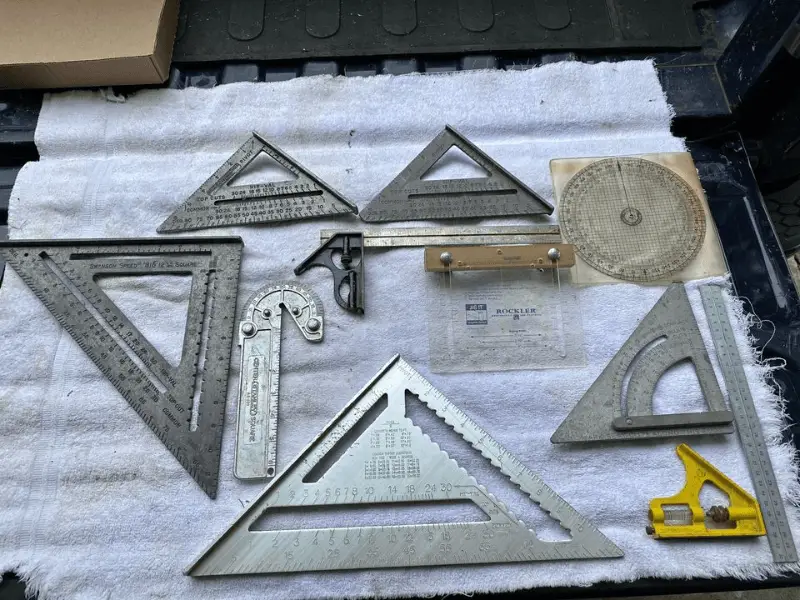When it comes to woodworking, everything starts with measurements. From the very outset of a project, you will be required to use measuring tools. You will use measuring tools for preparing the materials and establishing dimensions. Once the wood has arrived, the critical step of using various tools and techniques for transferring the measurements from the working drawings to the wood comes. Therefore, the fact that accuracy is crucial for good woodworking is very neatly summed up by the traditional adage, “Measure twice and cut once.”
However, with so many measuring tools, knowing which tools you require might take a lot of work. Therefore, let us have a comprehensive look at measuring instruments.
Basic measuring tools
Tape Measure
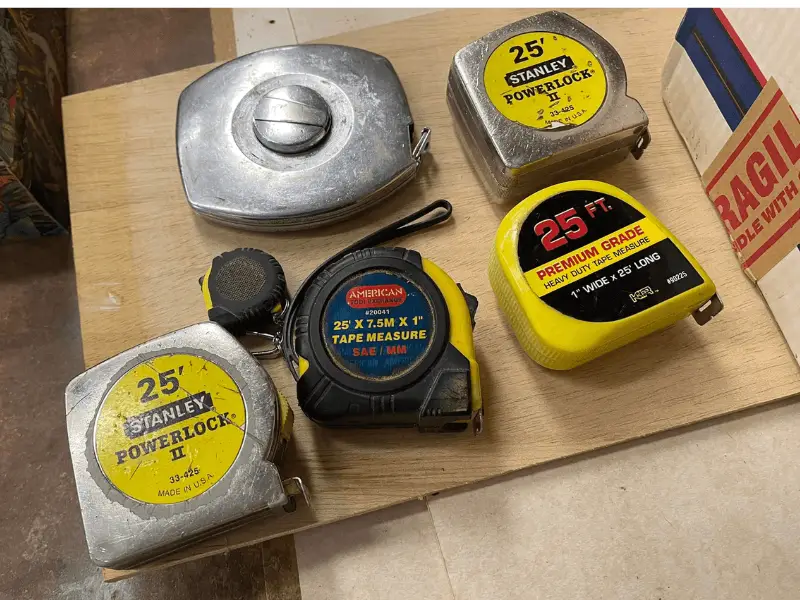
First up on our list is the humble tape measure, a tool as essential in your day-to-day life as it is in woodworking. This little champion will help you easily measure lengths, widths, and heights. In use, the end of the tape is hooked on the edge of the workpiece, and the hand-sized body is drawn out so that the sprung ribbon is pulled straight and stays rigid. When choosing a tape measure, choose one about 5 m (16 ft) long and calibrate it for both imperial and metric dimensions. This will help you convert from one system to another quickly and easily.
Squares
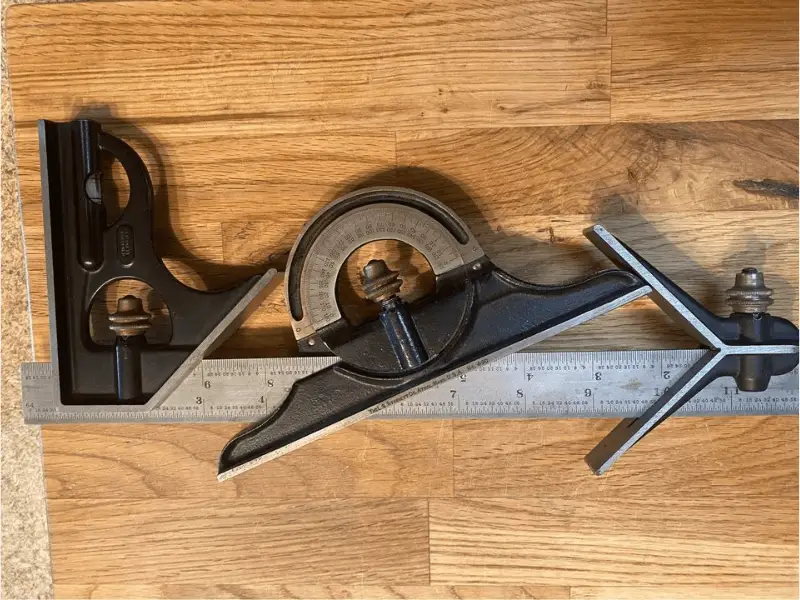
Next, let’s meet the try square and the combination square. These guys are your best friends in ensuring your projects’ right angles and straightness. Their spirit-level feature will help ensure your work is level and plumb. No more crooked shelves or lopsided tables!
The try square is primarily designed for bench work. The superior try square has an L-shaped blade, one arm encased in the wood. Lesser models have a strip of metal that is top-mounted to the wood.
The combination square has an adjustable stock that slides along the rule, locking with a thumbscrew. It is common to mark a 45-degree angle as a rule or level, as well as for checking depth.
There is another square known as the carpenter’s square, which is a single piece of L-shaped steel marked with various measurements and tables. The carpenter’s square is primarily used for large worktable tops, cupboard frames, and doors.
Measuring rules
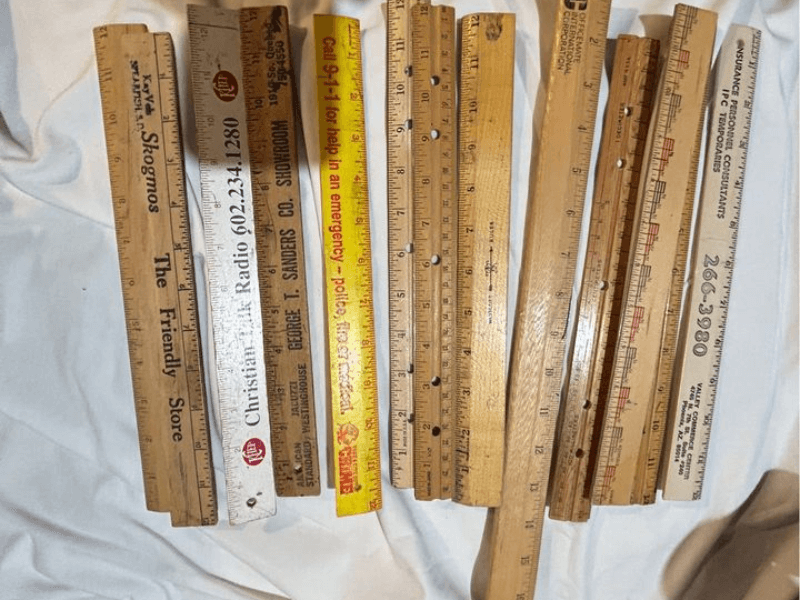
The traditional 2-foot four-fold boxwood and brass rule has long been considered the best all-around tool for measuring in woodwork. There are alternatives like folding extensions and two-fold rules, but the four-fold rule is still the most economical, easiest to use, and most versatile measuring tool for woodworkers.
Calipers
These are used for precise measurements crucial to making joints fit perfectly. Callipers remove the guesswork from your measurements, leaving clear, clean, and professional results behind. They’ll help you achieve incredible accuracy to the tiniest fraction of an inch.
There are three main types:
The outside callipers, which we use to measure the diameter of solid objects
The inside callipers for measuring the diameter of the inside holes, and finally, the double-sided callipers that the woodturner uses to pinch the wall thickness of a bowl and to transfer measurements from one tip to the other.
Remember, these tools are not just about accuracy but also about saving time and reducing waste. You’ll quickly create beautiful, precise pieces with the proper measuring equipment!
Choosing these tools is a crucial step in your woodworking journey. But don’t worry; there’s no need to break the bank. Start with a basic set, and as you gain confidence and expand your skills, you can invest in higher-end models.
Remember, the goal is not to have the most expensive tools, but the right ones. So take your time, do your research, and ensure you’re comfortable with your choices.
Dividers
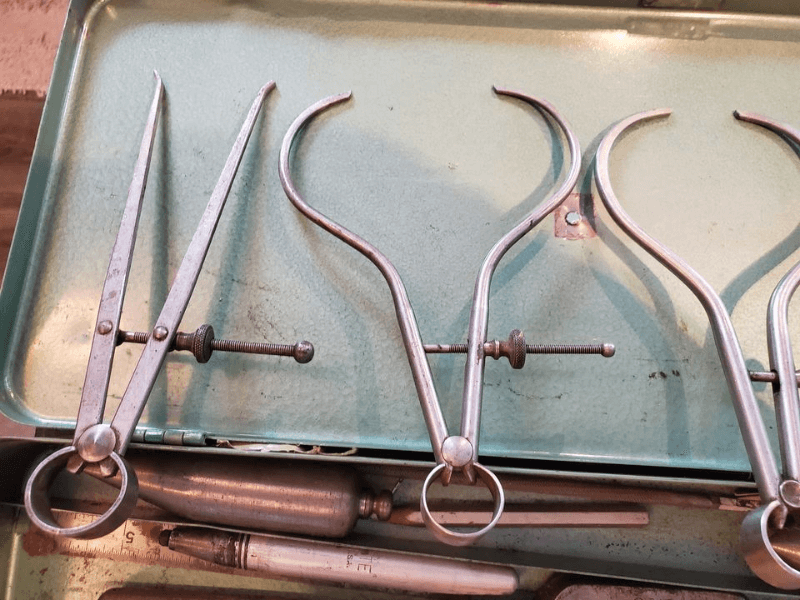
We use the dividers for reading measurements off a rule. You will use them when transferring measurements and scribing circles and arcs. A good divider has a screw-thread adjustment and a locking nut.
Brief History of Measuring Equipment
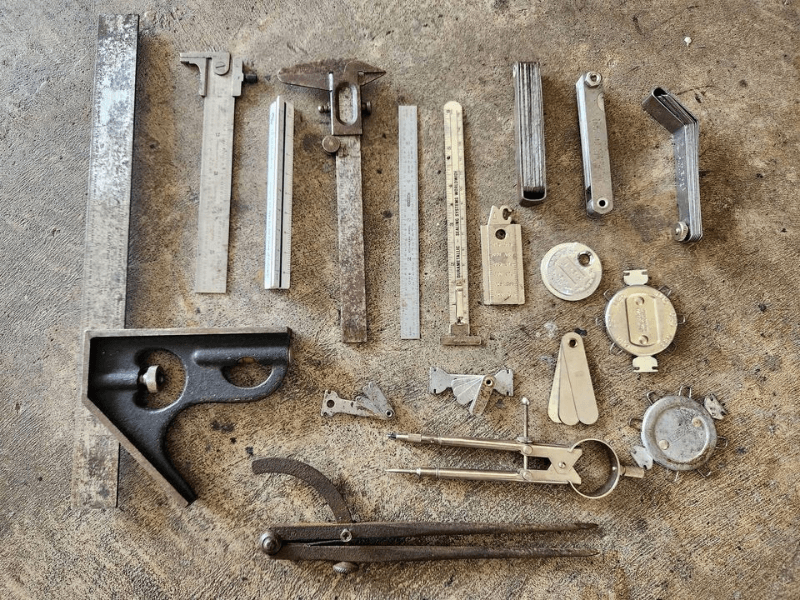
It’s easier to imagine life with our trusty measuring tools. They’re like the unsung heroes of every woodworking project, ensuring that each piece fits perfectly. But have you ever paused to consider the story behind these essential tools?
To date the history of measuring equipment, we must return to civilization’s dawn. Prehistoric humans would use body parts such as hands and feet as a standard measure, which, as you can imagine, could not have been more precise!
The Egyptians took things a step further. They invented the cubit, a standard measure based on the forearm’s length. This move was a significant leap forward, but it relied heavily on the individual’s arm’s length, leaving plenty of room for error.
When we fast forward to the Roman period, we see the introduction of the ‘foot’ as a standard measure. During this time, rudimentary measuring tools started to emerge, marking the beginnings of the equipment we now use.
They heralded a new era for woodworking and measuring equipment during the Renaissance period. During this time, precision became paramount, leading to the invention of more consistent and accurate tools. The ruler, as we know him today, was born!
Fast forward to modern times and the invention of laser and digital measuring tools, and we now have a wide array of precise instruments at our disposal. Despite all the technological advances, the essence of measuring remains the same: ensuring your woodworking projects are a perfect fit.
So, the next time you reach for your tape measure or ruler, remember the centuries of innovation that have led to that moment. It’s a beautiful testament to human ingenuity and the relentless pursuit of precision.
Picking your best measuring equipment set
First up, we have the classic tape measure. It’s a staple in any toolbox, not just for woodworking. It’s perfect for measuring longer lengths of wood and can be easily tucked away when not in use.
STANLEY Tape Measure
This fantastic tool, designed for professionals as well as weekend warriors, allows optimum use in all kinds of measuring circumstances. The highly portable tape may be used by just about anyone and is filled with a range of useful goods. Standard features include a belt clip for ease of use, a 1-inch wide blade for easy reading, indications for the centre of the studs at 16 and 19.2 inches, and a locking blade for precise measurements and little slippage. A heat-treated spring has also been added by Stanley to increase the lifespan of the tape.
This tape measure from Stanley is one of the most reliable and durable tools every woodworker should have in their measuring equipment set. It is suitable for heavy-duty carpentry/construction work. For the good features: It features a tape-lock switch, allowing you to hold your measurement in place while you work securely. The markings on the tape (one inch wide) are clear and easy to read in low light, and a helpful marking indicates the lower-edge length of the casing at three inches (which is accurate).
It’s made in the US. The spring inside is robust, so the tape happily retracts quickly, which is excellent for the impatient worker. The tape itself is highly curled to maintain its stiffness over long stretches, but this is both a good feature and a bug since it requires you to tip the edge of the tape down to mark precise lengths.
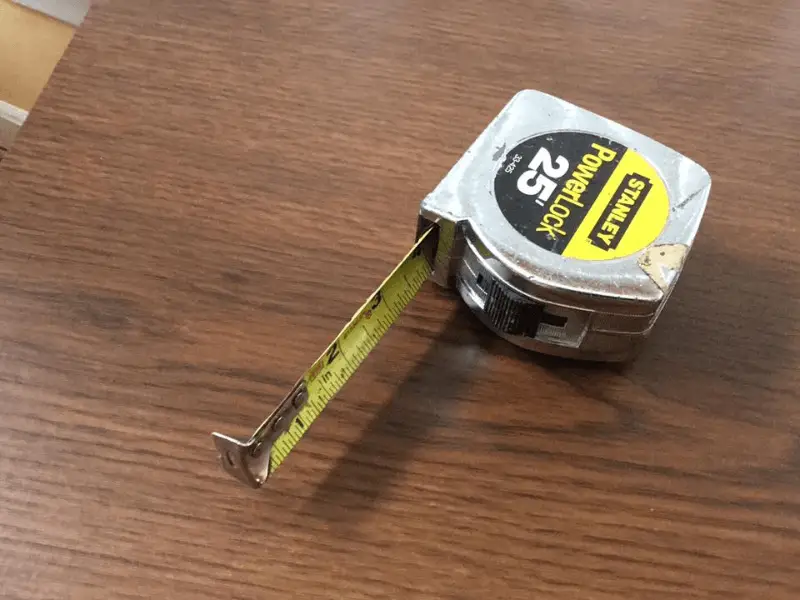
This model has only imperial markings, not metric; again, that is both a good feature and a bug: it helps to have consistent markings on both sides, but sometimes you need metric measurements, so in that case, you will need a combination measure.
The not-so-good feature, although not a deal-breaker for this price, is the case, which is made of plastic (it’s nevertheless sturdy and made to look and feel like steel, but it is not!). Another one is the tape-lock feature, which requires a fair amount of force to secure tightly.
The genuinely annoying problem is that the tape lock mechanism is backward: the tape should automatically lock at all times so the user can retract the tape when they want. Why would you want it any other way? Why, Stanley, why? I wish there were a low-priced alternative offered by Stanley that would switch these features and could be packaged together: this one plus another 10-foot measure that has imperial and metric markings, with a self-locking tape that is much flatter.
Overall, the Stanley Tape Measure, Chrome, 25-Foot (33-425) is a reliable and functional tool that will enhance the precision of your woodworking projects. Its tape-lock switch, clear markings, robust spring, and highly curled tape make it an excellent choice for any woodworker needing an accurate and durable measuring tool.
Starrett Steel Combination Square
Another must-have in any woodworking measuring equipment set is a good-quality square. A square is crucial for ensuring precise angles and straight lines.
One of the best squares on the market is the Starrett Steel Combination Square. It is a precision tool that every woodworker should have in their measuring equipment set. It is versatile, and you can use it for various purposes, including scribing right angles and parallel lines, measuring, tri-squaring, mitering, depth gauging, height gauging, and leveling.
When you're tired of fumbling around with the more "economical" options and hoping they're accurate, get a Starrett and never worry about it again. It is a Quality square that is accurate and easy to use.
It is made of hardened steel to ensure durability, which also helps ensure precise measurements. The blade is graduated in 8ths, 16ths, 32nds, and 64ths of an inch, offering precision that lets you easily make detailed measurements. Therefore, its durability, accuracy, and versatility make it a reliable choice for measuring and marking 90° and 45° angles in all your woodworking projects.
In addition to its precision and versatility, the Starrett Steel Combination Square is designed for comfort and ease of use. The square features a smooth, knurled nut that allows for easy and secure locking of the blade in position. The edge has a matte finish to reduce glare and enhance visibility while measuring and marking.

An important point to note When using the Starrett Combination Square, ensure that the square head and blade are correctly aligned to maintain accuracy. This can be done by checking that the blade’s edge is parallel to the edge of the square head. If any adjustments are needed, the square head can be adjusted using the square head adjusting screw.
Therefore, to use the Starrett Combination Square for measuring, place the square head against the edge of the material and extend the blade to the desired length. The engraved measurements on the blade allow precise measurements to be taken quickly and easily.
Overall, the Starrett Steel Combination Square is a reliable and accurate tool essential for any woodworker. Its versatility, durability, and precision make it valuable in any measuring equipment set. Whether you’re a beginner or a professional, investing in a high-quality combination square like the Starrett will ensure that your woodworking measurements are accurate, resulting in precise cuts and a finished product that exceeds your expectations.
FAQ
How do I choose the proper measuring tool for my project?
If you want to have the right measuring tool, always consider the specific needs of your project, such as the required accuracy and the type of measurements you’ll be making. Research different measuring tools and read reviews to find one that suits your needs.
What is the difference between imperial and metric measurements?
Imperial measurements are typically used in the United States, based on inches and feet. Metric sizes are used in most other parts of the world and are based on millimeters and centimeters. Therefore, you should consider choosing the measurement system that you’re most comfortable working with
How do I ensure accurate measurements?
To ensure accurate measurement, always Use the measuring tool correctly and take your time to ensure precision. Ensure the device is properly calibrated, and handle multiple sizes to double-check accuracy.
Conclusions
In conclusion, accurate measurements are crucial in woodworking to ensure precision and quality in your projects. The right measuring tools can make a significant difference in the accuracy and efficiency of your work. Whether you’re a beginner or a professional, investing in high-quality measuring equipment is essential.
